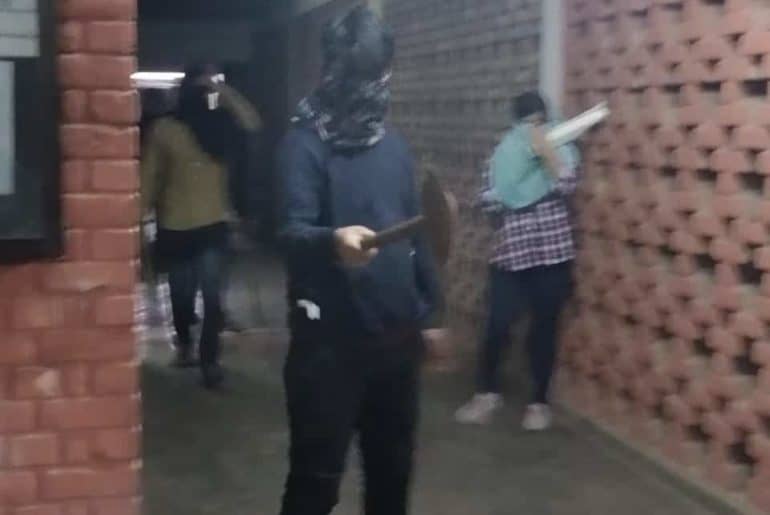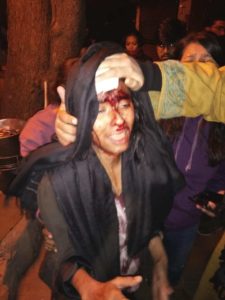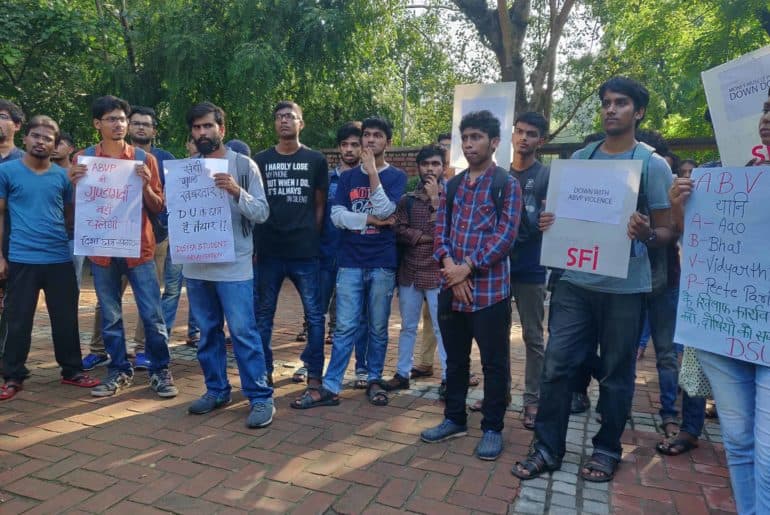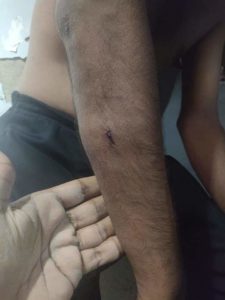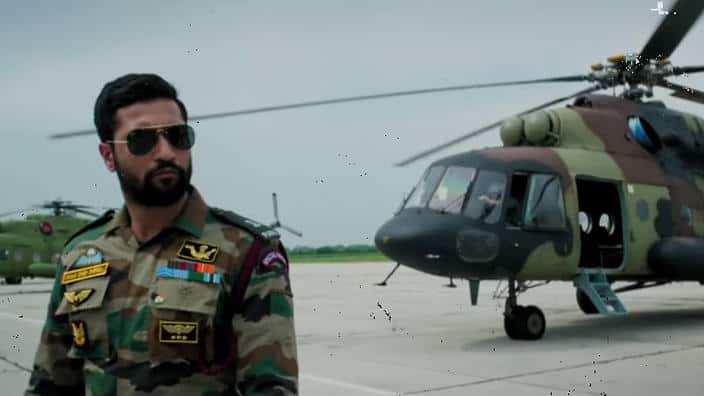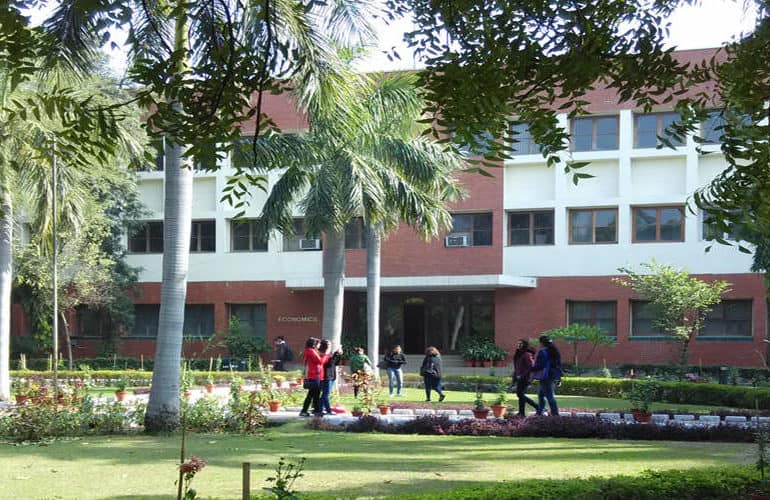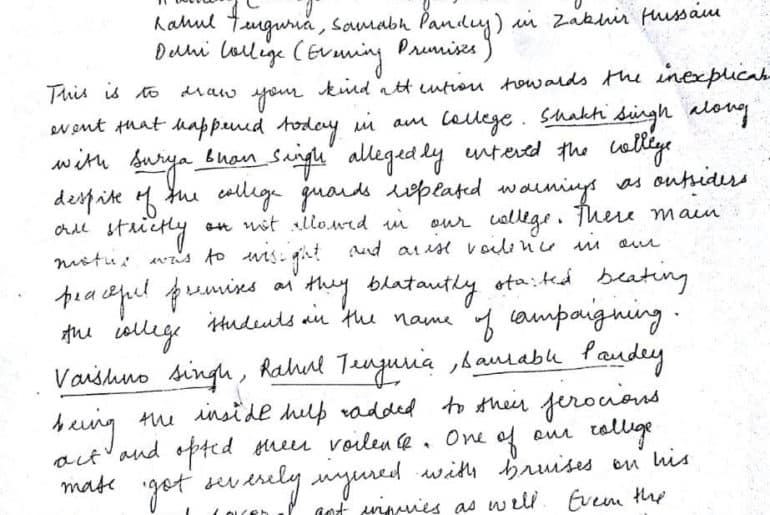Despite the Prime Minister’s assurance of unity through Ram, violence plagues several corners of the country while citizens remain delusioned by visuals of the Ayodhya temple and hopes and dreams of a Hindu Rashtra.
While diyas lit every corner of Bharat and saffron flags adorned its streets, flares of violence also followed suit to the Ram Mandir inauguration on January 22, 2024. While the mainstream media and internet algorithms keep you blinded by the glitter within the Ayodhya temple, communal sentiments have been on the rise in ‘Viksit Bharat’.
Gujarat, the Home-Ground of Saffron:
16 people were charged with “attempt to murder” in Bhoj village in Vadodara on the day of the inauguration. Allegedly, these persons were involved in pelting stones at the Shobha Yatra procession when it was passing by a masjid. According to the police, as the procession was going through the masjid lane, there was a heated encounter between the Hindu and Muslim communities, leading to the stone-pelting. The FIR lodged states that eight people in the procession were injured, including five women. 10 more people who were allegedly involved are yet to be identified.
This comes a day after a similar incident in Belim Vas in the Mehsana district. A procession was held on the eve of the consecration ceremony. According to the locals, it deviated from its planned route and reached a mosque. Videos have surfaced online showing how the group paraded, playing loud music and flashing swords and orange flags in the sensitive area. Fights broke out when the procession aggravated the Muslims, who were pleading with them to be quieter around the mosque. Stones were pelted, and the situation escalated fast, calling for police intervention. The Mehsana Police used teargas to bring back order and arrested 13 men, all Muslims. According to locals, it was a planned, provocative procession.
‘Ek hi Rashtra, Ek Hi Ram’ in Madhya Pradesh:
In Madhya Pradesh, the bhakts were celebrating the “victory” of their religion more than the inauguration of Ram Mandir. With passions high, young men were seen climbing small churches and planting saffron flags on the roofs, chanting “Jai Siya Ram ” with the utmost energy as bystanders cheered them on. This happened in four villages: Dabtalai, Matasula, Uberao, and Dhamaninathu in the Jhabua District. A pastor from the Matasula village told The Wire that at around 4 p.m. on Sunday (January 21), around 80 to 90 right-wing activists gathered near his house and started shouting provocative slogans.
“They were raising slogans, such as ‘Ek hi Rashtra, ek hi Ram,” he said.
The Christian community felt threatened by such an imposition of Hindu beliefs and didn’t even lodge an FIR out of fear, according to The Quint.
Mira Road and FTII Remind of Babri Masjid Scars in Maharashtra:
The scars of the Bombay riots in 1992 after the demolition of the Babri masjid were agitated on the 21st of January. 32 years after the horrific communal riots, the harmony that was so difficult to form was disturbed once again. Naya Nagar, an area in Mira Road, Mumbai, is primarily inhabited by Muslims who migrated from the main city after the bloody riots three decades ago. On the eve of the Pran Pratishtha, a series of Hindu processions celebrated their way through the streets of this area. It continued till late in the night, rousing tensions and consequently leading to violent exchanges.
At around 10:30 pm, a rally of bikes and cars passed through the area, shouting chants like “Jai Shree Ram” all the way. According to witnesses, the rally continued until a dead end, where a junior college stood. There was also a mosque nearby.
“Local residents thought the crowd was intentionally shouting slogans outside the mosque,” Sayed said to Scroll. Provoked, the residents expressed their anger, and fights soon followed. Stones were hurled, and the cars in the procession were attacked. A car carrying five people, including two women and a minor, was attacked as well, leaving them injured. While the victims deny any kind of provocation, a Hindu resident told Scroll, “They were loudly chanting slogans of ‘Jai Shri Ram’ late at night provocatively.”
A video of a Muslim man condemning the rallies and asking the Hindu groups to leave their community at peace angered netizens and even led to the arrest of the man for inciting violence. Ironically, when BJP leader Nitesh Rane posted a much more threatening post, warning the Naya Nagar residents that they would be beaten, no FIR was registered and no action was taken.
On the 23rd, in retaliation to the attacks on the rallies two days earlier, a radical decision was taken to demolish illegally established shops and properties owned by Muslims in that area. Municipal officials turned up with bulldozers and, without giving time to vacate belongings from the stores, destroyed entire establishments. Structures that had stood for years were selectively chosen based on whether the owners were Muslim or not and ruined in moments. While the municipality acted on instructions, Hindu mobs, blinded by rage, vandalised the stores of Muslims who had nothing to do with the violence that had ensued two days prior.
A video by the news outlet Maktoob Media has emerged on the internet that shows the mobs destroying the shop, not heeding the pleas of the old owner.
Communal conflicts weren’t limited to localities but extended to educational institutes as well. At the Film and Television Institute of India, Pune, a Hindu mob stormed the gates to burn a banner put up by the institute’s student association. The banner read, “Remember Babri, death to constitution, FTII student’s association.” The mob was involved in thrashing a few students as well, including the association’s president, Mankap Nokwoham. According to a press release by the association, their president was “violently attacked and brutally beaten.” An FIR was lodged against the 12–15 people who had broken into the campus, while six FTII students who were detained for displaying the banner were released on bail of Rs 30,00 each a few days ago.
Muslim Graveyard set afire in Bihar:
Reports arrive from Khirma village in the Darbhanga district of Bihar allegedly claiming that a procession celebrating the Ram Mandir ‘Pran Pratistha’ Ceremony threw a cracker inside a Muslim graveyard, causing it to go up in flames.
The Station House Officer at Keoti Police Station, Rani Kumari, reported to The Quint that:
“A Shobha Yatra was passing by a graveyard. Someone who was part of the Shobha Yatra lit a firecracker and threw it inside the graveyard, causing fire inside. The fire was subsequently contained, and an FIR has been registered. 12 people have been named in the FIR, and 50–100 are unknown individuals. No arrests have been made so far.”
Several videos have surfaced on X pertaining to the burning graveyard, and it is being claimed by the villagers that their collective efforts along with the fire brigade helped subside the fire. A video posted by Fatima Khan, a journalist at The Quint, shows citizens reporting to the police of the Shobha Yatra threatening to alight the district Masjid on fire as well. The video of the same can be found at this link.
14 Injured as Communal Clash Erupts in Bengal:
On January 24, merely two days after the Ram Temple Inauguration Ceremony, a gathering of two communities—Muslims and Hindus—clashes against each other in Howrah district of West Bengal as a religious procession turns violent.
The Quint reports that such violence erupted when Muslims took out an Urs procession on Wednesday night on the occasion of the birth anniversary of Hazrat Ali, the son-in-law of Prophet Mohammad, at Belilious road in Central Howrah. Muslims claim that provocative actions were taken up by the Hindus, who started the violence by chanting ‘Jai Shree Ram’, while Hindus blame the Muslims for stone-pelting and tearing their religious posters associated with Ram Mandir celebrations.
Vikram Singh, one of the victims of injuries during the clash, reported to The Quint that:
“We were inside our homes as it was chilly due to rains in the evening, but suddenly we were jolted by the noise of an unruly mob who began chanting slogans and tearing our religious posters and banners. We rushed outside and warned them against it. They went back after facing strong opposition from us, but soon returned within minutes and began to pelt stones on us. It was a sudden attack that left scores of us injured.”
Following such an incident on the 24th of January, the police have clamped Section 144 of the CrPC around the area, prohibiting a gathering of more than 4-5 persons. The Belilious road area in Howrah where the incident occurred has a population of around 3 lakhs, with both communities having almost equal numbers.
However, the Muslim community blames the Hindus for the assault. Zafar Ali, who claimed to be an eyewitness, told The Quint that a mob of around 1000–1500 people were participating in the religious procession, which started from a local market around 8.30 PM and was supposed to cover a distance of 800 metres before returning. He reports to The Quint that:
“The police had barricaded our destination from where we were supposed to return. The procession was peaceful till we reached the end point, but we heard slogans of Jai Shri Ram from the other side that were raised to provoke us. Some of our youths jumped the barricade and went to the other side, but they were attacked with swords and other sharp weapons. Soon, stone-pelting also began from the other side, and we were forced to run for our lives.”
It is being alleged that around 14 people were injured in this incident, including Sandip Pakhira, Officer-in-Charge of the Howrah Police Station, under whose jurisdiction the incident occurred. However, no arrests have been made so far. Howrah Commissioner of Police Praveen Kumar Tripathi said that steps have been taken to ensure peace, and the perpetrators are being located using CCTV footage.
Union Minister Smriti Irani, who was on a visit to Kolkata on January 25, 2024, grabbed this opportunity to claim that:
“The police were nowhere to be seen when the Ram devotees were pelted with stones, but they were out in big numbers to stop the live screening of PM Modi’s interaction with young voters in Kolkata. This shows that they have no respect for Ram devotees.”
Ironically, while Lord Ram is portrayed as a symbol of unification within Bharat, communal clashes make Ram devotees only localised to Hindus, linking citizenship within Bharat to faith!
History Repeats Itself in Karnataka:
Karnataka was the worst-affected south-Indian state after L.K. Advani’s Rath Yatra back in the 1990s. According to The News Minute, a South Indian news outlet, Karnataka was the third state after Uttar Pradesh and Gujarat to have suffered the brunt of blood and violence post-Rath Yatra. There was major rioting in four cities—Kolar, Davanagere, Ramanagara, and Channapatna—and the police responded with a shoot-to-kill spree. The sectarian clashes and police firings left 88 people dead by the time the Yatra exited the state. Since then, the communal situation in Karnataka has been fragile.
The flames of the 1990 Rath Yatra had only subsided when news of the Babri Masjid demolition reached every corner of the country on December 6, 1992. Karnataka again fell prey to prejudice and death. Bengaluru, Mysuru, and Gulbarga—cities that erupted in violence again; the air was thick with smoke, teargas, and fear. The post-demolition riots claimed 78 lives; 33 of them were due to police shootings.
Whooshing past to 2024, Section 144 has been imposed in several parts of Karnataka following skirmishes involving several stone-pelting incidents post-the Ram Mandir celebrations on January 22.
At Kalaburgi district, a procession of Lord Ram hosted by the Ram Utsav Samiti on account of the ‘Pran Pratistha’ Ceremony witnessed certain youths entering a restaurant owned by Zahoor Khan, chanting ‘Jai Shree Ram’ and threatening to close down the shop, according to the Hindustan Times. Consequently, several Muslim youths arrived at the scene, and turmoil erupted before the police arrived and took the situation under control by enforcing Section 144 across the area.
In Belagavi, three areas, deemed communally hypersensitive, experienced incidents of stone-pelting and police intervention. The Hindustan Times reports that unsettling events unfolded around 10.30 PM on Monday on Fort Road, Darbar Galli, and near the Head Post Office Circle in the Market Police sub-division. Police officials report that stone-pelting occurred from both Hindu and Muslim sides, and reserve forces were deployed to bring the situation under control, with the public being told to disperse. The areas concerned were densely populated by Muslims, and anonymous sources reported to the Hindustan Times that youths ‘celebrating forcibly’ flouted police barricades, chanted ‘Jai Shree Ram’ and burst firecrackers. Police officials mention that such provocations led to stone-pelting from both sides, and a lathi charge was used to disperse the groups.
On the same night, an Ambedkar statue was defaced with a garland of footwear at Kotnoor village, according to The Quint. This incident led to several protests from Dalit organisations, and the police tried to pacify the situation by offering a garland of flowers to the statue.
Nevertheless, Section 144 was hailed to the rescue across Karnataka!
Telangana Shocks the Nation!
Not just Karnataka, Telangana has also entered the list of states in South India that have fallen prey to the communal plague.
On the day of Ram-Mandir consecration, a fruit shop owned by a Muslim man was set ablaze against allegations of a shoe being thrown into the Ram-Mandir procession in the Sangareddy district of Telangana. The News Minute reports that ‘provocative slogans’ were raised while the shop was set on fire. According to the shop owner, all the produce within the shop has been damaged, and the loss amounts to nearly twenty thousand. Police officials report that, upon investigation, it was found that the shoe-throwing incident was not linked to the Muslim whose shop was burned down. An FIR was previously registered, and a police case has been registered against the violence-perpetrating mob under Sections 147 (punishment for rioting), 148 (rioting armed with a deadly weapon), and 435 (using fire or explosives with intent to cause damage), read with Section 149 (every member of an unlawful assembly guilty of an offence committed in prosecution of a common object) of the Indian Penal Code (IPC).
In an unrelated incident reported by Maktoob Media, a Muslim teenager was paraded naked by a Hindutva group at Morgi village in the same district. The 19-year-old Muslim boy was assaulted, paraded naked, and sent to jail by the Hindu mob along with four other Muslim men against allegations of insulting the saffron Hindu religious flag in an online video.
The teenager was accused by the Hindutva mob of disrespecting the saffron flag and posting it on social media, and he was arrested along with four other men who helped him make that video.
“Tumhari aukaat humare pairon ki dhool (your status is the dust on our feet). We are Muslim; don’t forget it,” a voice in the background can be heard saying in the video, which the teenager allegedly posted on social media. The police had booked five men, including Abbas, under IPC Sections 153A (promoting enmity between groups), 253A (offending religious beliefs), and 505 (2) (promoting hatred or ill-will).
Villagers of Morgi and adjacent villages reached Morgi in large numbers, caught the 19-year-old boy, thrashed him, and attacked him by pushing him to the ground in full public view. The teenager was also stripped and paraded naked. The Hindutva mob also threw fire on his private part, but he managed to douse it before it hurt him. The brutal attack was also shot by one of the Hindu men and shared on social media.
A case has been registered against the Hindutva mob, but no arrests have been made yet. The case was registered under IPC Sections 341 (wrongful restraint), 323 (voluntarily causing hurt), 505 (2) (statements conducing to public mischief), and 506 (criminal intimidation).
Uttar Pradesh: The Heart of Ram Rajya
Uttar Pradesh housing the Ram Temple in Ayodhya is the growing ground of Hindutva post-Gujarat, with growing chants across the nation of ‘Kaashi Mathura Abhi Baaki Hai’.
Incidents have been reported from Lucknow where ‘hateful communal songs’ were played by a procession celebrating the Ram Mandir ceremony near Narhi, Hazratganj. An FIR has been registered against the organiser of a ‘bhandara’ (public feast) who was playing such songs in the area. Two people have been arrested in connection with the song. The FIR has been registered under IPC 294 (singing, reciting, or uttering any obscene song in public).
“Ambedkar Nagar, Akbarpur of Uttar Pradesh, is a Muslim-majority area located on the border of Ayodhya, and police officials have reported several FIRs against hateful speeches and songs perpetrated by both Hindu and Muslim communities on social media. Besides, regular meetings with religious and administrative heads have been organised since the Ram Temple consecration to maintain peace and security in the area, an anonymous official residing within Akbarpur, Uttar Pradesh, said.
Communal tensions have been on the rise and are reaching the edge with the increase in the number of communal media elements around the nation. While hate speeches and prejudices continue in the name of religion, peace in the long term is no less than a delusion.
As Lord Ram slowly becomes the face of ‘Viksit Bharat’, a question remains unanswered: Are hate songs, unruly mobs, and Shut-it-Down with Section 144 the new way of Naya Bharat? The upcoming Lok Sabha elections will determine the degree and intensity of the same.
Read Also: When Saffron Sparks Debates: Exploring the Aftermath of Ram Mandir Inauguration
In Educational Spaces
Featured Image Credits: The Quint
DU Beat





